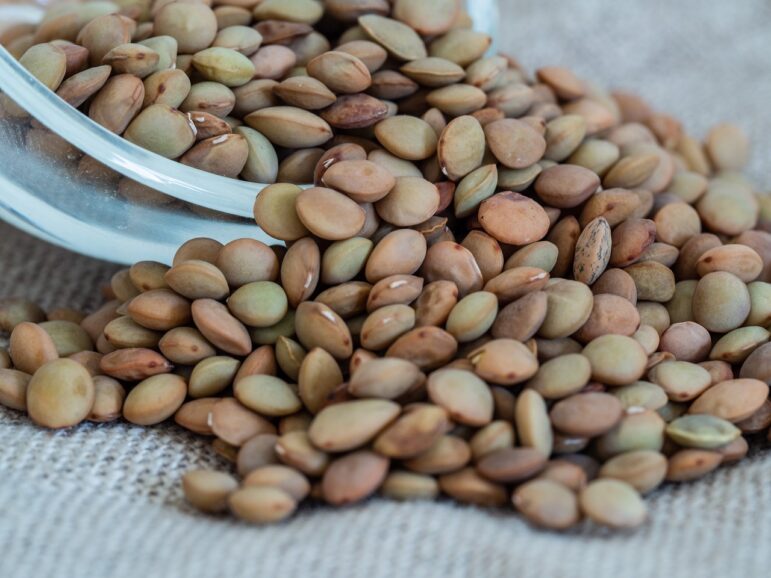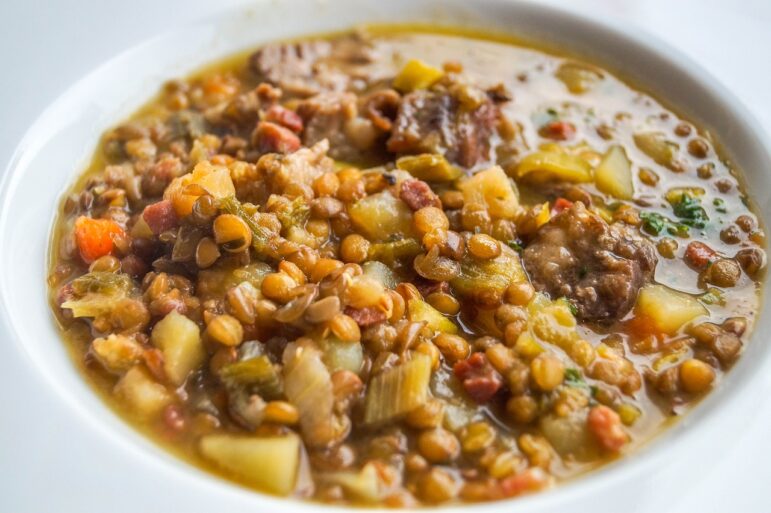
Lentils made us who we are.
One of the eight “neolithic founder crops” domesticated in the fertile crescent 12,000 years ago, lentils are protein and fibre rich, full of necessary vitamins and minerals, making them an incredibly important food source for our early agrarian ancestors. But like most technological advances, the changes wrought by the development of agriculture weren’t entirely positive. Slowly, food production went from being a communal activity that all benefited from to a matter for individual families, and with that, social inequality, as well as the increasing subordination of women, took root. By the Bronze Age, lentils, as an abundant, nutrient dense crop, had become a poverty food, one relied on by those who couldn’t afford a diet of meat and wheat bread instead.
Despite, or perhaps because of, this, lentils are associated with wealth and good fortune when it comes to folk magic, with a soup intended to improve the family fortunes over the coming year just one of the ways this ancient legume has played a magical role in our lives.

Lentils [martin-hetto, Pixabay]
For the Romans, lentils resembled low-denomination copper coins. Giving a pouch full of them as a gift acted as a form of sympathetic magic, a wish that the bearer would soon have a pouch full of real coins to spend. This connotation has carried forward in parts of Italy, and among Italian-Americans, with lentils making it onto their New Year’s tables as a means of securing good luck and prosperity in the year to come. Here lentils join with grapes, pickled herring, pork and sauerkraut, and Hopping John – traditional foods eaten by different cultures at New Year to bring wealth and good fortune to the diners.
With lentils, it’s said the more of them we eat, the better our luck and the deeper our pockets in the coming year, encouraging people to lay down a good layer of protein and fibre in their alcohol-filled stomachs. (If nothing else, starting the New Year without, or at least a greatly diminished, hangover sounds pretty magical.)
From there, the association between lentils, coins, and good fortune spread to parts of France and Spain, with a similar soup (the fatty cotechino sausage subbed out for Toulouse sausages or chorizo) eaten just after midnight during New Year’s celebrations. Hungary and the Czech Republic do similarly, with specific, delicious-sounding, lentil soups traditionally making up the first lunch of the New Year (which, let’s face it, is probably actually the first meal too – the thick, easy to digest, electrolyte filled soups ideal for putting into a hungover stomach).
![]()
The Wild Hunt is grateful for the recent support.

The Wild Hunt is very grateful to our readers for your recent financial support and amazing words of encouragement. We remain one of the most widely-read news sources within modern Paganism, and our reporters and columnists remain dedicated to a vision of journalism for and about our family of faiths.
As a reminder, this is the type of story you only see here. This is how to help:
Tax Deductible Donation | PayPal Donations | Join our Patreon
You can also help us by sharing this message on your social media.
As always, thank you for your support of The Wild Hunt!
![]()
In parts of Latin America, lentils aren’t just eaten for luck, but carried (in dried form) around in pockets or given to others, Ancient Roman style, as gifts on New Year’s Day. In Peru the tradition is taken even further, with Lunes de Lentejas, Lentil Mondays, where families eat lentils every Monday to bring them prosperity throughout the week.
Given the nutritional benefits, not to mention the low price, of lentils, this seems like something we could all benefit from.
Of course soup itself is one of those foods that inherently seems magical. Maybe it’s images of witches standing over bubbling cauldrons, or the conviction of mothers and grandmothers everywhere that soup will cure what ails us, but soup as a food just feels like magic – both when we make it and later when we’re curled up enjoying it.
There’s plenty of folklore attesting to that, with magical soups cropping up around the world that can heal or hurt, that can bestow forgetfulness or wisdom. While I make no claims about this soup in particular, magical or otherwise, it is currently my favourite, with my wife and I eating it about once a week (or, to be truthful, once for dinner and then several days for lunch as well).
Maybe the weekly dose of lentils will bring us luck and good fortune (hopefully, given the U.K.’s just entered another recession), but even if they don’t it’s still a good soup.

Lentil soup [mygraphx, Pixabay]
Spiced Lentil Soup
- 2 cans of green or brown lentils/230g dried green or brown lentils
- 230g rice
- 2 large white or yellow onions
- As much fresh garlic as your heart desires
- Cumin
- Nigella seed
- Nutmeg
- Tumeric
- Ginger powder
- Black Pepper
- Fenugreek
- Bay leaf
- Fresh or dried chilli to taste
- Vegetable Stock
- Olive Oil and/or Butter
- Salt
If you’re using dried lentils, soak them overnight and then pour away the water. This step is important, because it gets rid of a lot of the lecithin that would otherwise cause gastrointestinal distress. If using tinned, then no need to soak; however, pouring away the liquid they’ve been preserved in is similarly a good idea.
If using butter, then start by melting some in a saucepan and add some olive oil. (If making a vegan version, then just omit the butter.) Fry up the diced onion, garlic, and any whole spices you’re using – but be warned, nigella seeds tend to spit as they heat up so be careful during this process. Once the onions are turning translucent, add the vegetable stock, rice, lentils, and the other spices, and set to a rolling boil for ten minutes before reducing to simmer.
This is one of those maddening recipes where you’re cooking with your heart when it comes to spices rather than specific measurements, because it really is a matter of personal taste and how strong you want your flavours to be. Start with two teaspoons of everything, let the flavours meld a little, then start adding more, depending on which flavours you want to come out more strongly in the finished broth. I tend to sprinkle enough of the powdered spices that there’s a fine layer across the broth for a moment before it starts to sink, sometimes adding more of one spice or another later on.
Once you’re happy with the flavours and the lentils are a good texture, add the rice and then allow it to cook until it’s reached your preferred texture – average 10 minutes, but your grain and mileage may vary). Once it’s ready, you can add more butter for a particularly rich and luxurious version of the soup, as well as salt to taste.
Don’t forget to remove the bay leaf before serving!
The Wild Hunt is not responsible for links to external content.
To join a conversation on this post:
Visit our The Wild Hunt subreddit! Point your favorite browser to https://www.reddit.com/r/The_Wild_Hunt_News/, then click “JOIN”. Make sure to click the bell, too, to be notified of new articles posted to our subreddit.